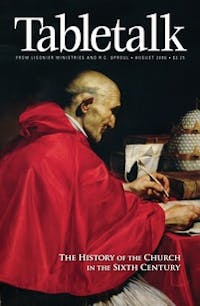
Request your free, three-month trial to Tabletalk magazine. You’ll receive the print issue monthly and gain immediate digital access to decades of archives. This trial is risk-free. No credit card required.
Try Tabletalk NowAlready receive Tabletalk magazine every month?
Verify your email address to gain unlimited access.
In reading the “lives of the saints” it is difficult to the point of impossibility to discover the unvarnished truth. That is certainly true in the case of Columba, or Columcille, the Irish missionary to the Scots and Picts in the second half of the sixth century. Columba’s biography, written by Adamnan one hundred years after his death, contains all the stock-in-trade elements of medieval hagiography: visions and revelations, prophecies, visitations of angels, healings, resurrection of the dead, and battles against dark forces (including, in Columba’s case, banishing by the sign of the cross a sixth-century ancestor of the Loch Ness monster).
Once we have done the detective work to separate the wheat from the chaff, however, certain facts seem to remain.
Columba was born of a noble family around 521 in Donegal, Ireland, and died on the island of Iona, off the west coast of Scotland, in 597. Early destined for the priesthood, he later took monastic vows and kept them with a feisty zeal (he is attributed with founding twenty-five monasteries and forty churches by the age of twenty-five!). His quick and stubborn temper appears to have been the catalyst for clan warfare and multiple deaths. According to tradition, his spiritual adviser, Molaisi of Devenish, commanded him to seek the conversion of an equal number of souls as those whose deaths he had caused.
In any event, around the age of forty-two Columba seems to have undergone a radical change and committed himself to the missionary enterprise. Along with twelve companions he set sail across the Irish Sea and landed on Iona, which thereafter became his base of operations for the conversion of two of the major tribes on the Scottish mainland, the Picts and the Scots, as well as the northern English.
What Columba really believed and taught remains opaque to us (Celtic Christianity in Scotland maintained important differences from Roman Christianity until the influence of Queen Margaret in the eleventh century). But his story illustrates several important principles that recur in the annals of the expansion of the Christian church.
The first principle is that mere strategies for evangelism are never the real cause of its lasting impact. Personal commitment is. E.M. Bounds’ oft-quoted words have been true throughout the centuries: “Men are looking for better methods; God is looking for better men. Men are God’s methods.” However impossible it now is to decipher Columba’s personal faith in the accretions of hagiography, the depth, determination, and persistence of his commitment to his cause is beyond doubt. The kingdom of Christ prospers on passion properly directed to its extension. That passion may not be unsullied; the prosperity may not be immediate; but they belong together in the divine recipe for kingdom advance. After all, did not His disciples particularly notice the Lord’s zeal (John 2:17)?
Second, where we live and serve is not the ultimate determining factor in our spiritual influence. It would to some seem heretical to say it, but the fact is that Iona is on the road to nowhere. There is a lesson here, reflected in the lives of contemporary Christians too. World vision does not require residence in a great city in order to thrive. Is there a developing deviation in some evangelical circles today that only big-city, big churches, and their pastors are where the kingdom action is? But Augustine’s Hippo was not Rome, Athens, or Constantinople. Can you put Northamptonshire on a map? (Why would you do that? It was there that William Carey’s passion for world mission was born). So we could go on. Everywhere is equidistant from the power and presence of God. We must never forget this if we find ourselves in a sphere judged small by the world, or, sadly, by the sometimes over-worldly church.
The third principle is that God’s way, customarily, is to advance His cause through spiritual brotherhoods (not meaning exclusively male societies). Herein lay part of the power of the monastic movement, and certainly of Columba’s mission: he and his companions, bound together by their common vision, were prepared to risk all for the cause and for one another. This pattern goes back through Scripture to the schools of the prophets, to the Lord and the apostles, to the apostolic missions, to Augustine and his friends, to the great Reformers, and, perhaps most notably in our own history, to the Puritans and to the Great Awakening. Iron sharpens iron.
Columba’s story thus serves to encourage us to pray that God would raise up laborers for His harvest, and bind them together to live, serve, and — if need be — give all for Christ and His cause. This, so often, has been the instrument God uses to advance His kingdom into future generations.
Come to think of it, in some sense it is probably true that I, my family, and many of our closest friends, are Christians today because of Columba.
But who will be a Christian tomorrow because of us?
